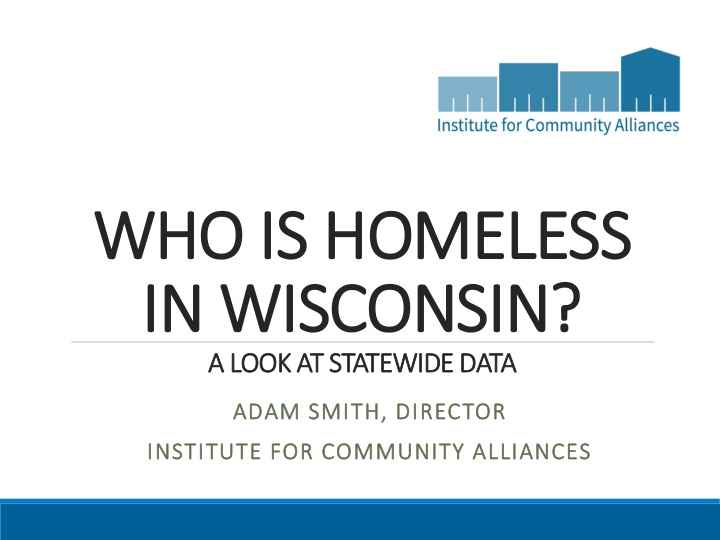



WHO IS HOMELESS IN WISCONSIN? A LOOK AT STATEWIDE DATA ADAM SMITH, DIRECTOR INSTITUTE FOR COMMUNITY ALLIANCES
About the Data Sources Data are reported from two origins: Longitudinal: count over time, typically 12-month period Point-in-Time: single day snapshot 2 1/25/17 WWW.ICALLIANCES.ORG
About Homeless Management Information System (HMIS) HMIS is the primary source of homeless data in Wisconsin Statewide database generates unduplicated counts of people served by homeless programs 3 1/25/17 WWW.ICALLIANCES.ORG
HMIS Nuts and Bolts Organizations providing specific services to people experiencing homelessness document client level data in system Services include: emergency shelter, transitional housing, street outreach, rapid re-housing, permanent supportive housing, case management, and eviction prevention Client level information is used to create a variety of aggregate reports 4 1/25/17 WWW.ICALLIANCES.ORG
HMIS Report Examples Total people served by date range, program, etc. Program performance Trends Demographics Progress Program utilization 5 1/25/17 WWW.ICALLIANCES.ORG
Continuum of Care (CoC) Basics A Continuum of Care (CoC) is a collaboration of service providers (non-profits, government, health care, etc.) working together towards the common goal of providing solutions to homelessness in communities across the state CoCs also apply for competitive annual federal funding to provide housing and supportive services in their communities 6 1/25/17 WWW.ICALLIANCES.ORG
Four CoCs in Wisconsin Milwaukee City/County Madison/Dane County Racine City/County Balance of State Due to large geographic reach of Balance of State, most meetings and organization is further broken down into smaller regions High-population counties typically operate as one CoC 7 1/25/17 WWW.ICALLIANCES.ORG
The Numbers (Some of Them) Between October 2015 and September 2016, homeless services providers in Wisconsin reported serving 22,050 people in emergency shelter and transitional housing in Wisconsin 8 1/25/17 WWW.ICALLIANCES.ORG
22,050 In Depth 46% were in families with minor children 58% were served outside Dane & Milwaukee Counties 9% were U.S. military veterans 8% met the federal definition for chronic homelessness 2% were unaccompanied youth under the age of 18 9 1/25/17 WWW.ICALLIANCES.ORG
In Depth, Continued 88% of people served from October 2015 – September 2016 were served in emergency shelters, totaling 19,312 people 28% (5,332 people) were youth under the age of 18 The average age of a sheltered person is 30.4 years old 10 1/25/17 WWW.ICALLIANCES.ORG
11 1/25/17 WWW.ICALLIANCES.ORG
Emergency Shelter Use by County, October 2015 – September 2016 12 1/25/17 WWW.ICALLIANCES.ORG
Point-in-Time (PIT) Data Point-in-Time data are used to create a snapshot of homelessness on a single day/night within a jurisdiction Count is of people in literal homeless situations: on streets/place not meant for human habitation, emergency shelters, transitional housing programs Count is inclusive of ALL providers in state Count is conducted on same night throughout state 2017 count is TODAY 13 1/25/17 WWW.ICALLIANCES.ORG
Point-In-Time Recent Trends Region: 2014 2015 2016 Balance of State 3,569 3,597 3,445 Milwaukee County 1,499 1,521 1,415 Racine County 210 168 196 Dane County 777 771 629 5,685 Totals 6,055 6,057 14 1/25/17 WWW.ICALLIANCES.ORG
2016 Count In Depth 22% had a severe mental illness 22% were victims of domestic violence 15% had chronic substance abuse 7% were veterans 6% were chronically homeless 6% were unaccompanied youth under the age of 25 188 youth under the age of 25 were parents to 267 children 15 1/25/17 WWW.ICALLIANCES.ORG
2016 Count In-Depth, Continued People equally distributed between single people and people in families 7% of people counted were in places not meant for human habitation Severely mentally ill comprise largest sub- population of people counted 16 1/25/17 WWW.ICALLIANCES.ORG
Total homeless people in Wisconsin PIT count, 2007-2016 17 1/25/17 WWW.ICALLIANCES.ORG
18 1/25/17 WWW.ICALLIANCES.ORG
Progress is Happening Continua of Care are replacing transitional housing programs with permanent rapid re-housing programs Continua of Care have also implemented a coordinated entry system, which prioritizes people for the most appropriate services available (i.e., no longer first-come, first-served) 19 1/25/17 WWW.ICALLIANCES.ORG
Progress, Continued Additional programs targeted to specific populations have been developed: State Programs Street Outreach Program for homeless veterans Rapid Re-Housing Program for youth aging out of foster care Expanded a program aimed at assisting homeless people access SSI/SSDI (SOAR) 20 1/25/17 WWW.ICALLIANCES.ORG
The Interagency Council Key stakeholders from various state departments and key community organizations convene quarterly Functions of the council include: Reviewing data Information sharing Identifying needs and gaps Improving inter- and intra-agency coordination Fostering systems change and improvement 21 1/25/17 WWW.ICALLIANCES.ORG
For More Information Additional Interactive Data Can be Found on Our Website: http://www.icalliances.org/wisfamilyimpact 22 1/25/17 WWW.ICALLIANCES.ORG
Recommend
More recommend